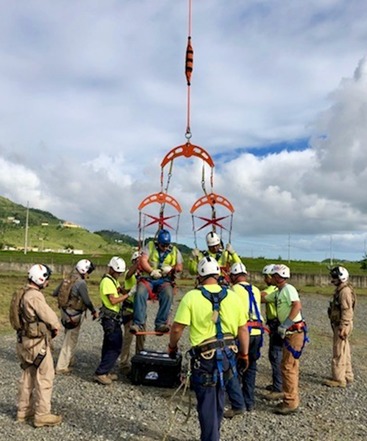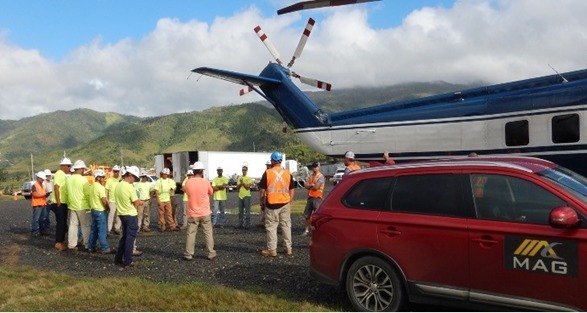
When tragic natural disasters hit, organizations like the Federal Emergency Management Agency (FEMA) rely on companies like MAG Aerospace to deliver critical life-saving resources and services to those in need. MAG plays a crucial role in disaster response through wildfire and hurricane aircraft support, in addition to on-ground resources and recovery.
In 2017, Nature’s fury manifested in the forms of Hurricanes Irma and Maria, two cataclysmic events that would forever etch their names in the minds of those who experienced them.
Irma, an unforgiving Category 5 hurricane, tore through parts of the Caribbean and Florida, inflicting over $50 billion in damages. Just as communities were grappling with this devastation, Maria, another relentless Category 5 storm, zeroed in on Puerto Rico and the U.S. Virgin Islands.
FEMA’s mission was clear: assess the damage, assist the affected, and amplify the speed of recovery. But it would not be an easy effort as it would become FEMA’s largest air support response to an event both inside and outside of the United States.
MAG Responded Promptly with Hurricane Aircraft Support – “Eyes in the Sky”
FEMA needed eyes in the sky. They needed MAG’s expertise to manage the crisis efficiently.
“When the request for support comes, we set aside any other task we’re performing and it’s all hands on deck,” said Jason Leal, MAG’s FEMA Program Manager.
MAG would wind up providing the lion’s share of the contracted hurricane aircraft support. The fallout from the hurricanes was immediate and devastating. Infrastructure crumbled, power lines went dark, and vital communication pathways were severed. Thousands were trapped, anxiously waiting for relief and a sign that they were not forgotten. With no time to lose, MAG prepped their fleet. Specialized aircraft with every piece of machinery equipped with state-of-the-art sensors and imaging technology. As the aircraft soared into the skies, the collaboration between man, machine, and nature began.
MAG’s skill set was crucial, as the missions were anything but routine. The landscapes they operated in bore little resemblance to the places they once knew. The first task was to map out the affected areas.
MAG’s aircraft buzzed over submerged neighborhoods, capturing critical images, from the structural damage of homes to isolated areas where people might be stranded, that would help FEMA determine where aid was needed most.
MAG swiftly established an Air Bridge, a lifeline that would connect the territories and ensure that help reached every corner, no matter how remote. Transporting essential goods that carried hope, signaling to the beleaguered residents that recovery was on the horizon.
Airports, once bustling hubs, were now mazes of debris. Yet, every takeoff and landing by MAG was executed with little or no problem or disruptions to services, while using only Visual Flight Rules (VFR) and managing other adverse conditions.
Disaster Response Commitment Beyond the Cockpit

MAG’s dedication wasn’t confined to the skies with hurricane aircraft. Specialist teams, comprised of experienced personnel, were dispatched directly to the hardest-hit areas.
Collaborating shoulder-to-shoulder with FEMA officials ensured that disaster relief operations were streamlined, effective, and, most importantly, compassionate. MAG’s aerial teams coordinated with ground teams, directing them to blocked roads, broken bridges, and compromised infrastructure. MAG’s aerial perspective was instrumental in making real-time decisions.
Every morning and evening, the MAG team would huddle with FEMA, poring over the data and imagery. Together, they strategized for the next day’s operations, always with the goal of helping as many people as possible, as quickly as possible.
MAG’s footprint on the ground vastly improved communications with FEMA and enhanced the efficiency of ground operations and utilization of aircraft.
“In the wake of disaster, MAG becomes a lifeline, delivering essential aid and support to those in need,” Leal added. “Our collaboration with FEMA is a testament to the power of swift action and commitment we’re able to provide.”
MAG’s Disaster Response Plan
MAG has a proven track record of supporting disaster relief efforts around the world. For example, they played a key role in the response to Hurricane Harvey, and wildfires in Canada and California.
In the aftermath of a disaster, MAG can quickly deploy its resources to provide essential services, such as:
- Maintenance and Logistics Support: Reliability is key during emergencies. MAG ensures that its aerial systems are always ready to deploy by providing top-notch maintenance and logistical support. This ensures that FEMA can rely on MAG’s capabilities whenever they are needed, without concerns of downtime or system failures.
- Real-time Wildfire & Hurricane Aircraft Surveillance: MAG’s ability to conduct real-time aerial surveillance stands out as a crucial component in disaster response. Whenever natural disasters strike, FEMA requires swift, accurate, and comprehensive data to coordinate their response effectively. MAG’s advanced aerial systems provide detailed, real-time visuals of affected areas, allowing FEMA to pinpoint crisis spots and deploy resources more effectively.
- Data Analytics and Processing: It’s not just about capturing data but processing it efficiently to extract actionable insights. MAG’s data analytics solutions transform vast amounts of aerial data into easy-to-understand formats. This aids FEMA in analyzing the scale and nature of disasters quickly, enabling faster decision-making processes.
- Special Mission Training: MAG also offers specialized mission training, which can be tailored to FEMA’s unique requirements. This ensures that FEMA personnel are well-equipped and knowledgeable about leveraging MAG’s capabilities to their fullest, ensuring efficient disaster response and recovery.
- Geospatial Information Services: In the wake of a disaster, understanding the lay of the land becomes essential. MAG Aerospace’s geospatial capabilities allow FEMA to get a detailed understanding of the affected terrain, ensuring resources are directed most efficiently.
- Communication Solutions: Efficient communication is the backbone of any emergency response. MAG provides advanced communication solutions that guarantee seamless connectivity even in the most challenging environments, allowing FEMA to stay coordinated and informed at all times.
MAG and FEMA – a Blend of Technology and Purpose in Turbulent Times
The partnership between MAG and FEMA represents a blend of technology and purpose. While MAG provides the tools, technology, and expertise, FEMA leverages these capabilities to maximize their disaster response efficiency. Together, they ensure that when disasters strike, the response is swift, coordinated, and effective.
“Each emergency response flight we undertake with FEMA is more than a mission; it’s a promise to communities that in their challenging moments, they are not alone and have support,” Leal said.
While we often recognize the frontline organizations rushing to aid, MAG’s pivotal role during and after Hurricanes Irma and Maria showcases the profound impact of the company’s capabilities during a crisis. In the aftermath of a disaster, MAG can quickly deploy its resources from hurricane aircraft footage to provide essential services, such as:
- Aerial surveillance and reconnaissance
- Damage assessment
- Communications support
- Search and rescue
- Medevac
- Airdrop
MAG’s skills are not just about state-of-the-art technology but about how this technology is tailored to meet the specific needs of agencies like FEMA. The collaboration is a testament to how public-private partnerships can enhance the effectiveness of disaster management, ensuring that help reaches those in need as quickly and efficiently as possible.
MAG continues its unwavering commitment to humanitarian aid through partnerships with FEMA and others. In 2022, the company provided aerial support to FEMA and other responders during Hurricane Ida and the Western U.S. wildfires.
MAG Continues to Support FEMA for Additional Disaster Relief

As recently as this year, MAG has supported FEMA’s efforts in Maui during the wildfires in August and in Guam after Typhoon Mawar by providing air transportation support services and urban search and rescue missions.
MAG is committed to supporting disaster relief efforts around the world. The company’s experienced crews and state-of-the-art aircraft are an asset to responders during times of crisis.
“We take pride in carrying the banner of hope and working hand-in-hand with FEMA to bring relief and recovery to the heart of crisis-hit areas,” Leal said.
So, the next time you hear about a disaster relief effort, remember that it’s not just the big organizations, like FEMA or the Red Cross, that are making all the difference. Companies like MAG are working tirelessly to help people in need.
As history has shown, challenges will always arise, and communities will once again find themselves facing adversities and MAG will be ready to use their resources and expertise to help.

